 |
|
October 5, 2022 the
cinematic James Bond franchise celebrates its 60th anniversary.
007 MAGAZINE looks back at the production of Dr. No, the first film
adventure in the long-running series. KEVIN HARPER unearths rare and
previously unknown facts about the making of the ground-breaking film that
began the 007 film franchise - which changed the face of world cinema
forever! |
|
First published in the UK
in April 1953, Ian Fleming’s James Bond novels were very popular in the UK
and across the Commonwealth, but by the early 1960s had yet to become
widely read in the USA. It was not until March 1961 when
US magazine LIFE
published the list of President John F. Kennedy’s 10 favourite books that
this suddenly changed. The inclusion of FROM RUSSIA, WITH LOVE at number
nine on the list increased Ian Fleming’s readership in the USA overnight,
and his novels then started to be reprinted in paperback with great
success by Signet Books. Always with an eye on taking Bond to the big
screen, in late 1960 Ian Fleming met with Harry Saltzman, the UK based
Canadian producer of Look Back In Anger (1959), Saturday Night
And Sunday Morning (1960) and The Entertainer (1960). Saltzman
took out a six-month option on the James Bond novels (with the exception
of CASINO ROYALE – the screen rights had been sold in 1954) and then
feverishly went to work trying to find a financial backer for the first
film. Unbeknownst to Saltzman, UK-based American producer Albert R.
Broccoli had also been interested in filming the James Bond novels, and
the pair were introduced via their mutual friend screenwriter
Wolf Mankowitz. |
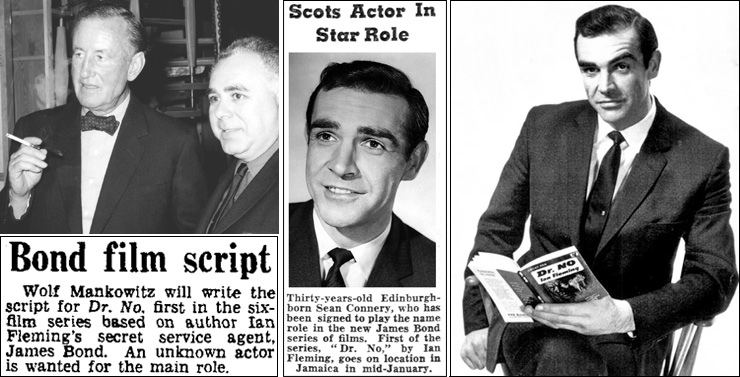 |
|
ABOVE: (top left)
Author Ian Fleming with Canadian-born producer Harry Saltzman, who
took out a six-month option on the James Bond novels in late 1960
[pictured on the set of Goldfinger (1964)].
(bottom left) On July 21, 1961 it was announced that Wolf Mankowitz would write the script for the first in a series of six James Bond films.
(centre) Scottish actor Sean Connery is announced as James Bond on
November 3, 1961. (right) An early publicity still of Sean Connery
holding the recently published PAN Books paperback edition of DR. NO. |
|
|
|
With time running out on
Saltzman’s option, the producers entered into a reluctant partnership and
agreed to make the films together. After Broccoli’s home studio Columbia
turned them down the pair flew to New York and met with United Artists
executives on June 21, 1961. After a very short meeting UA agreed to
finance the first film for a budget of $1 million, and the deal was then
announced in industry journals and by the press worldwide on June 29,
1961. The first film at this stage was either going to be based on
DIAMONDS ARE FOREVER or DR. NO and would be made by Saltzman’s own company
Lowndes Productions, instead of Broccoli’s Warwick Films. As
pre-production work on the first project began, a new company called EON
Productions was formed to produce the films, and for tax purposes a second
company DANJAQ (the first three initials of Broccoli & Saltzman's
respective wives’ names - Dana and Jacqueline) responsible for the
copyright and trademarks to the characters, elements, and other material
related to James Bond on screen. Saltzman's Canadian citizenship allowed
them to base DANJAQ in Switzerland. |
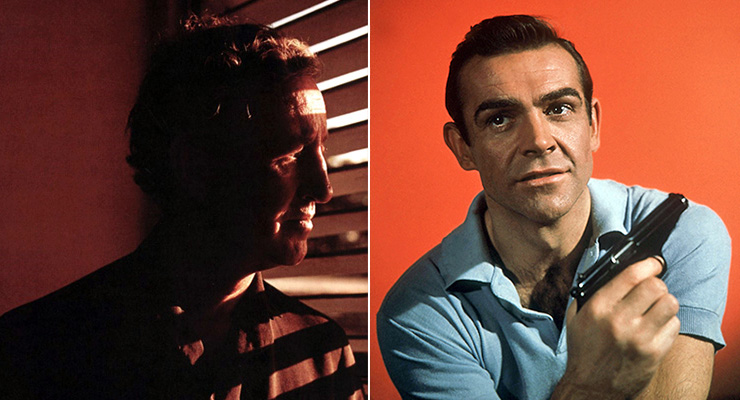 |
|
Ian Fleming’s most recent
novel, THUNDERBALL (1961), was also considered as the first film, but the
title quickly became the the subject of a lengthy court battle between the
author and Irish filmmaker
Kevin McClory. A new screenplay had even been
written by Broccoli’s frequent collaborator Richard Maibaum and delivered
to EON Productions on August 18, 1961, but shelved when he began work on Dr. No.
Richard Maibaum's original 1961 Thunderball screenplay is barely
recognisable as the style of James Bond scripts that would follow. Ian Fleming's 1958 novel DR. NO had
itself been based upon a script written by the author for a proposed US TV
series, to be called Commander Jamaica. Four of the short stories
in the FOR YOUR EYES ONLY anthology (1960) had also been based on scripts
for this proposed TV series. Harry Saltzman entrusted Johanna Harwood with
the adaptation of DR. NO, although he had originally approached acclaimed
TV writer Nigel Kneale (1922-2006), with whom he had recently collaborated
on several Woodfall Productions, but the mercurial Manxman declined the
offer. Broccoli’s friend Wolf Mankowitz also delivered a 102-page draft
that included the idea of Doctor No being the name of the villain’s pet
monkey! Mankowitz then stepped away not wishing to take any screen credit
on the project. The producers wanted to remain close to Fleming’s original
so far as was possible. The final screenplay was based on elements from
all adaptations, and ultimately credited to
Richard Maibaum,
Johanna
Harwood and English author John Evan Weston-Davies – known as
Berkely
Mather. Harwood stayed with EON Productions and co-wrote the screenplay to
Call Me Bwana (1963) with Richard Maibaum, and then adapted FROM
RUSSIA, WITH LOVE and GOLDFINGER for the screen, although would be
uncredited on the latter together with Berkely Mather, who had written the
second draft. |
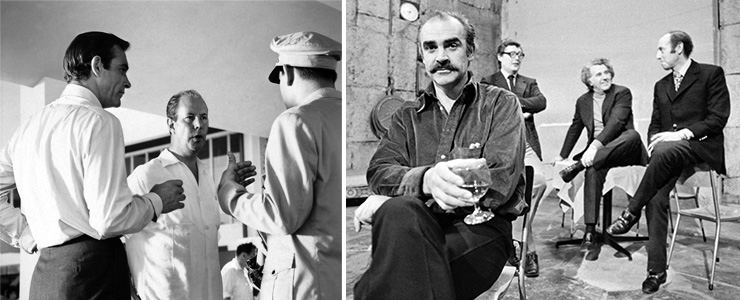 |
|
ABOVE: A LASTING
BOND (left) Sean Connery with director Terence Young (and Reggie
Carter) at Palisadoes Airport on the first day of location filming
on Dr. No (1962). Terence Young had first directed Sean
Connery in Action of the Tiger (1957). The pairing would continue with From
Russia With Love (1963) and Thunderball (1965). Their
friendship lasted until Terence Young's death in 1994. (right)
Acting as an Associate Producer on Dr. No was Stanley Sopel - a role he would repeat
on the next six James Bond films. When Sean Connery departed the
EON Productions series for the final time in 1971 he set up his
own company to produce The Offence (1972). Tantallon Films
was a four-man partnership between Connery, his agent Richard
Hatton, British film producer Denis O'Dell, and seven time James
Bond associate producer Stanley Sopel [above L-R], with whom
Sean Connery had remained on good terms since their first meeting
on Dr. No in 1961. |
|
|
|
Also involved in the
production of Dr. No from day one as an associate producer was
Albert R. Broccoli’s frequent Warwick Films collaborator,
Stanley Sopel.
Many directors were originally considered including Guy Hamilton (who
would later direct four James Bond films from 1964-1974),
Ken Hughes,
Val
Guest (who would both direct segments of Casino Royale in 1967) and
Bryan Forbes (1926-2013). Eventually the job went to another of ‘Cubby’
Broccoli’s friends and Warwick Films collaborators, Terence Young, who
signed his contract on October 15, 1961, although Harry Saltzman and
United Artists were not convinced he was the right choice as director, as
he was well-known for going over schedule and over budget. The financier
and distributor were also not convinced that Saltzman & Broccoli’s choice
of actor to play James Bond was right either - however, after a lengthy
search they had both agreed that Sean Connery was the man for the job, and
offered him the role that would change his life forever! On November 3,
1961, it was announced in the press that 30-year-old Scottish actor Sean
Connery had been signed to play Ian Fleming’s secret agent James Bond in a
new series of films, and that shooting on Dr. No would begin in Jamaica in
mid-January 1962. |
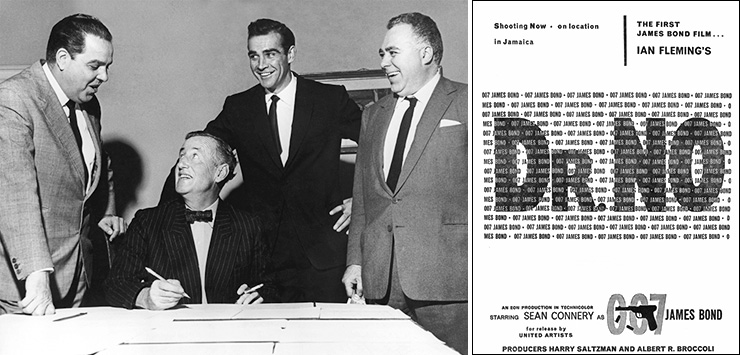 |
|
ABOVE: (left) Dr.
No Co-producer Albert R. ‘Cubby’ Broccoli with James Bond
author Ian Fleming, actor Sean Connery and EON Productions partner
Harry Saltzman. (right) A trade magazine announcement confirming
the start of location shooting on the first James Bond film in
Jamaica. |
|
|
|
Although Sean Connery had
refused to take part in a formal screen test, he did agree to play
opposite several actresses trying for the role of Miss Taro in a day of
tests directed by Terence Young at Pinewood Studios on Thursday December 21, 1961.
The four actresses testing were Talitha Pol (1940-1971) the Dutch model
and Sixties fashion icon who is best-remembered for becoming the second
wife of John Paul Getty Jr. in 1966; Tina Margo [listed on the call-sheet
as Lina]; Violette Marceau and Zena Marshall (1926-2009) - who would
ultimately secure the role. It was these tests that finally convinced
United Artists that Connery was the right choice after all. Among those
testing for the role of Honey Ryder was 19-year-old actress Gabriella Licudi
(1941-2022), who would later play the small role of Eliza (one of M’s many
daughters) in Casino Royale (1967). The sequence chosen for the
test was from the scene by the waterfall on Crab Key Island when Honey
tells Bond (who is cleaning his Walther pistol with a rag) that Doctor No
killed her father. The scene was filmed on a beach set of rocks with a sky
backing. Although Ted Moore (1914-1987) was hired as cinematographer on
Dr. No the lighting cameraman for the day of tests was Geoffrey
Unsworth (1914-1977), later the celebrated director of photography on
Stanley Kubrick’s 2001: A Space Odyssey (1968), Bob Fosse’s
Cabaret (1972) [for which he won an Academy Award], Sidney Lumet’s
Murder On The Orient Express (1974), Richard Attenborough’s A
Bridge Too Far (1977), Richard Donner’s Superman The Movie
(1978) [the film is dedicated to Unsworth]. Unsworth ended his career with
Roman Polanski’s Tess (1979), which earned him a second Academy
Award. Geoffrey Unsworth died of a heart attack at the age of 64 during
filming in France, with the Oscar presented posthumously and shared with
cinematographer Ghislain Cloquet (1924-1981), who finished the film. |
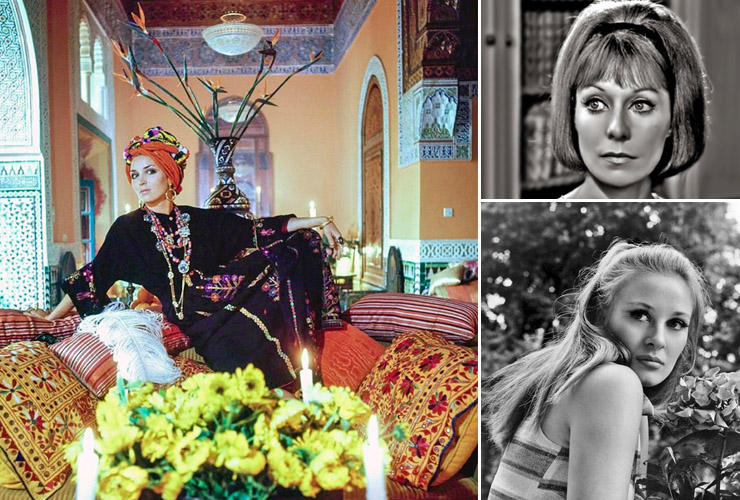 |
|
ABOVE: (left) Dutch
model and Sixties’ fashion icon Talitha Pol (then married to John
Paul Getty Jr.) photographed in her Marrakesh living room by
Patrick Lichfield (1939-2005) for Vogue January 1970. (top right)
Violette Marceau who also tested for the role of Miss Taro in
Dr. No. (bottom right) Testing for the role of Honey Ryder was
19-year-old actress Gabriella Licudi , who would later play the
small role of Eliza (one of M’s many daughters) in Casino
Royale (1967).
BELOW: (left) EON Productions’ unit progress report for the day of
tests at Pinewood Studios on December 21, 1961 directed by Terence
Young and photographed by Geoffrey Unsworth. [inset] Sean Connery
played opposite the several actresses testing for the role of Miss
Taro and also posted for publicity stills. It was these tests that
finally convinced financier and distributor United Artists that
Sean Connery
was the right choice for the role of James Bond. (bottom right) Zena Marshall
[photographed by Terry O'Neill] who would ultimately secure the role of Miss Taro,
and would accompany Sean Connery to the Gala Screening of Dr.
No at the London Pavilion on October 5, 1962. |
|
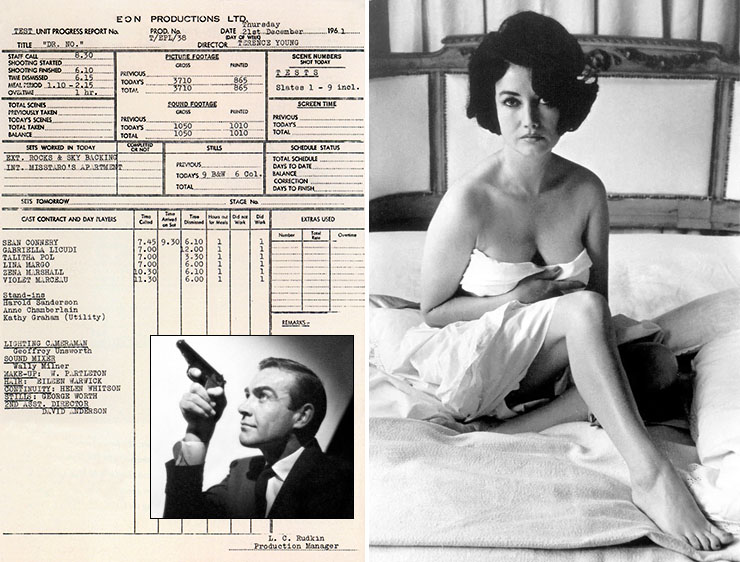 |
|
|
CONTINUED
>> |

|

